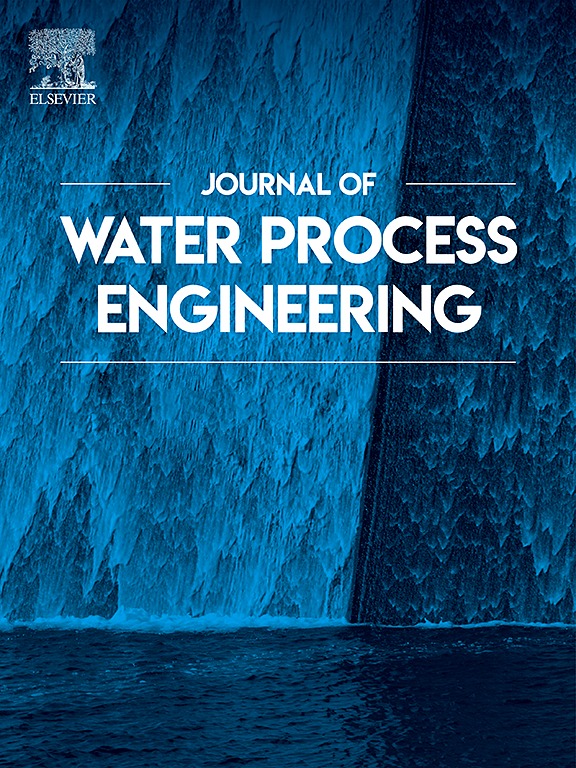三电极生物电化学系统中高氨和亚硝酸盐积累对生物阴极的双重抑制作用:电化学活性和微生物演替
IF 6.7
2区 工程技术
Q1 ENGINEERING, CHEMICAL
引用次数: 0
摘要
在三电极生物电化学系统中施加恒定电位(20 mV vs饱和甘汞电极)被认为是研究生物阴极对高氨负荷响应而不受其他干扰的有效方法。在本研究中,氨氮浓度按100、300、450和600 mg L−1的步骤逐渐增加。最大输出电流从26.12±1.51 mA急剧下降到11.64±1.35 mA,部分原因是游离氨的抑制作用。同时,随着氨氮的增加,亚硝酸盐积累时间的延长与输出电流的滞后相相关,表明亚硝酸盐毒性是限制生物阴极输出性能的另一个因素。此外,较高的氨氮浓度显著抑制了阴极还原电流,当氨氮浓度超过450 mg L−1时,阴极还原电流明显下降。然而,基于高铵浓度的电导率的增加仅略微降低了电荷转移电阻(Rct),但不能完全抵消游离氨的抑制作用。值得注意的是,高氨和亚硝酸盐积累的双重抑制作用还体现在微生物群落丰富度的降低,以及反硝化功能细菌(如铁杆菌)和硝化细菌(如硝化螺旋菌)的丰度减少。因此,全面研究不同氨负荷对生物阴极的抑制作用,为了解实际废水处理中微生物电化学系统(MES)中高氨冲击对生物阴极的影响提供了理论支持。本文章由计算机程序翻译,如有差异,请以英文原文为准。

Dual inhibitory effects of high ammonia and nitrite accumulation on biocathode in three-electrode bio-electrochemical system: Electrochemical activity and microbial succession
Applying a constant potential (20 mV vs. saturated calomel electrode) to a three-electrode bio-electrochemical system is considered an effective method to investigate the biocathode's response to high ammonia load without other interferences. In this study, the ammonia nitrogen concentration was gradually increased in steps of 100, 300, 450, and 600 mg L−1. The sharp decrease in the maximum output current, from 26.12 ± 1.51 mA to 11.64 ± 1.35 mA, was partly due to the inhibition caused by free ammonia. Meanwhile, the prolonged duration of nitrite accumulation with increasing ammonia nitrogen correlated with the lag phase of output current, suggesting that nitrite toxicity was another factor limiting the biocathode's output performance. Moreover, the cathodic reduction current was significantly inhibited by higher ammonia concentrations, with a marked decline when ammonia nitrogen levels exceeded 450 mg L−1. However, the increase of conductivity based on high ammonium concentration only slightly reduced the charge transfer resistances (Rct) but could not fully counteract the free ammonia inhibition. Notably, the dual inhibitory effects of high ammonia and nitrite accumulation was also reflected in the reduced richness of microbial community, along with a decrease in the abundance of denitrifying functional bacteria (e.g., Ferruginibacter) and nitrifying bacteria (e.g., Nitrospira). Thus, a comprehensive investigation into the inhibitory effects of different ammonia loads on the biocathode provides theoretical support for understanding the impact of high ammonia shocks on biocathode in microbial electrochemical system (MES) during practical wastewater treatment.
求助全文
通过发布文献求助,成功后即可免费获取论文全文。
去求助
来源期刊

Journal of water process engineering
Biochemistry, Genetics and Molecular Biology-Biotechnology
CiteScore
10.70
自引率
8.60%
发文量
846
审稿时长
24 days
期刊介绍:
The Journal of Water Process Engineering aims to publish refereed, high-quality research papers with significant novelty and impact in all areas of the engineering of water and wastewater processing . Papers on advanced and novel treatment processes and technologies are particularly welcome. The Journal considers papers in areas such as nanotechnology and biotechnology applications in water, novel oxidation and separation processes, membrane processes (except those for desalination) , catalytic processes for the removal of water contaminants, sustainable processes, water reuse and recycling, water use and wastewater minimization, integrated/hybrid technology, process modeling of water treatment and novel treatment processes. Submissions on the subject of adsorbents, including standard measurements of adsorption kinetics and equilibrium will only be considered if there is a genuine case for novelty and contribution, for example highly novel, sustainable adsorbents and their use: papers on activated carbon-type materials derived from natural matter, or surfactant-modified clays and related minerals, would not fulfil this criterion. The Journal particularly welcomes contributions involving environmentally, economically and socially sustainable technology for water treatment, including those which are energy-efficient, with minimal or no chemical consumption, and capable of water recycling and reuse that minimizes the direct disposal of wastewater to the aquatic environment. Papers that describe novel ideas for solving issues related to water quality and availability are also welcome, as are those that show the transfer of techniques from other disciplines. The Journal will consider papers dealing with processes for various water matrices including drinking water (except desalination), domestic, urban and industrial wastewaters, in addition to their residues. It is expected that the journal will be of particular relevance to chemical and process engineers working in the field. The Journal welcomes Full Text papers, Short Communications, State-of-the-Art Reviews and Letters to Editors and Case Studies
 求助内容:
求助内容: 应助结果提醒方式:
应助结果提醒方式:


